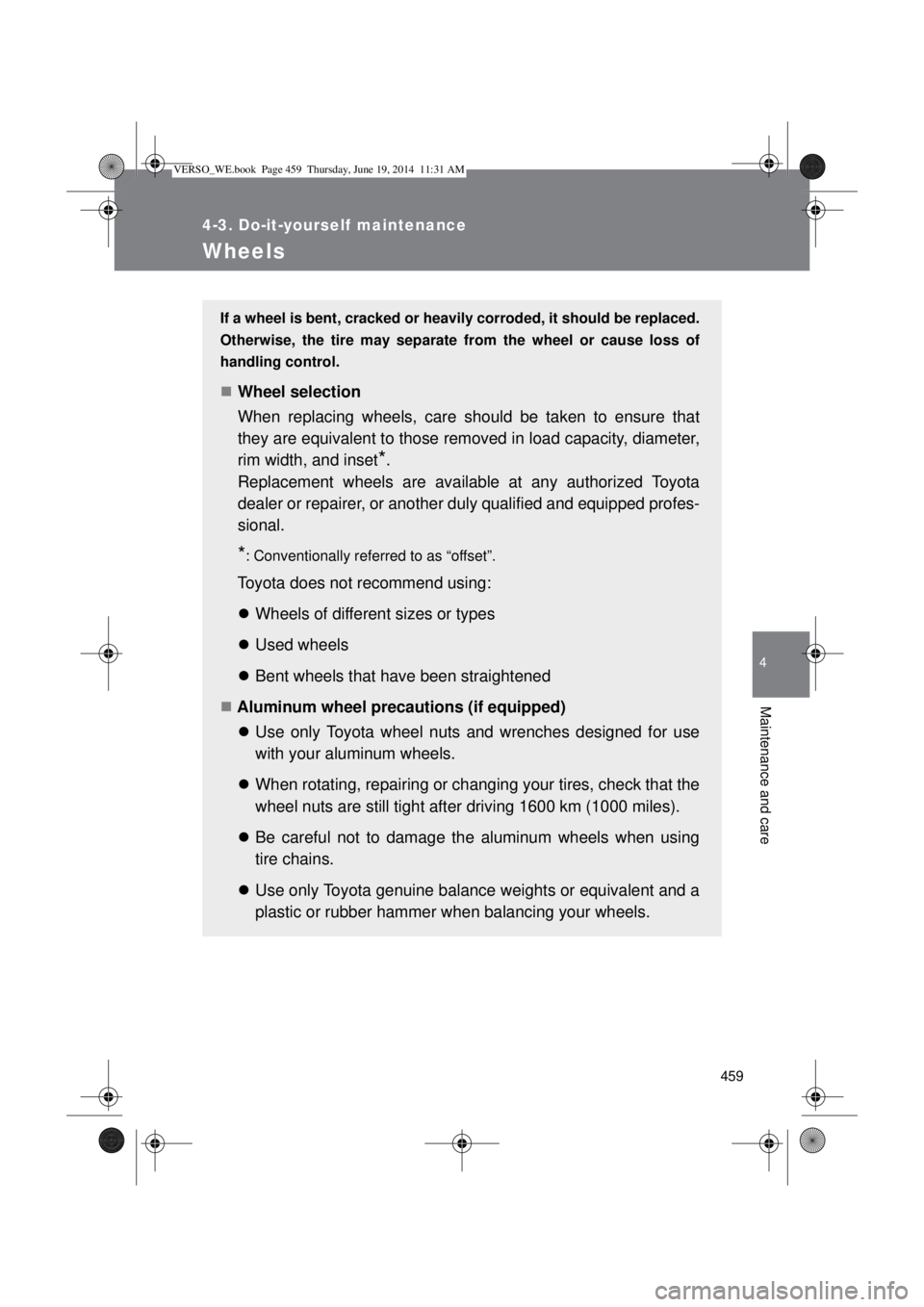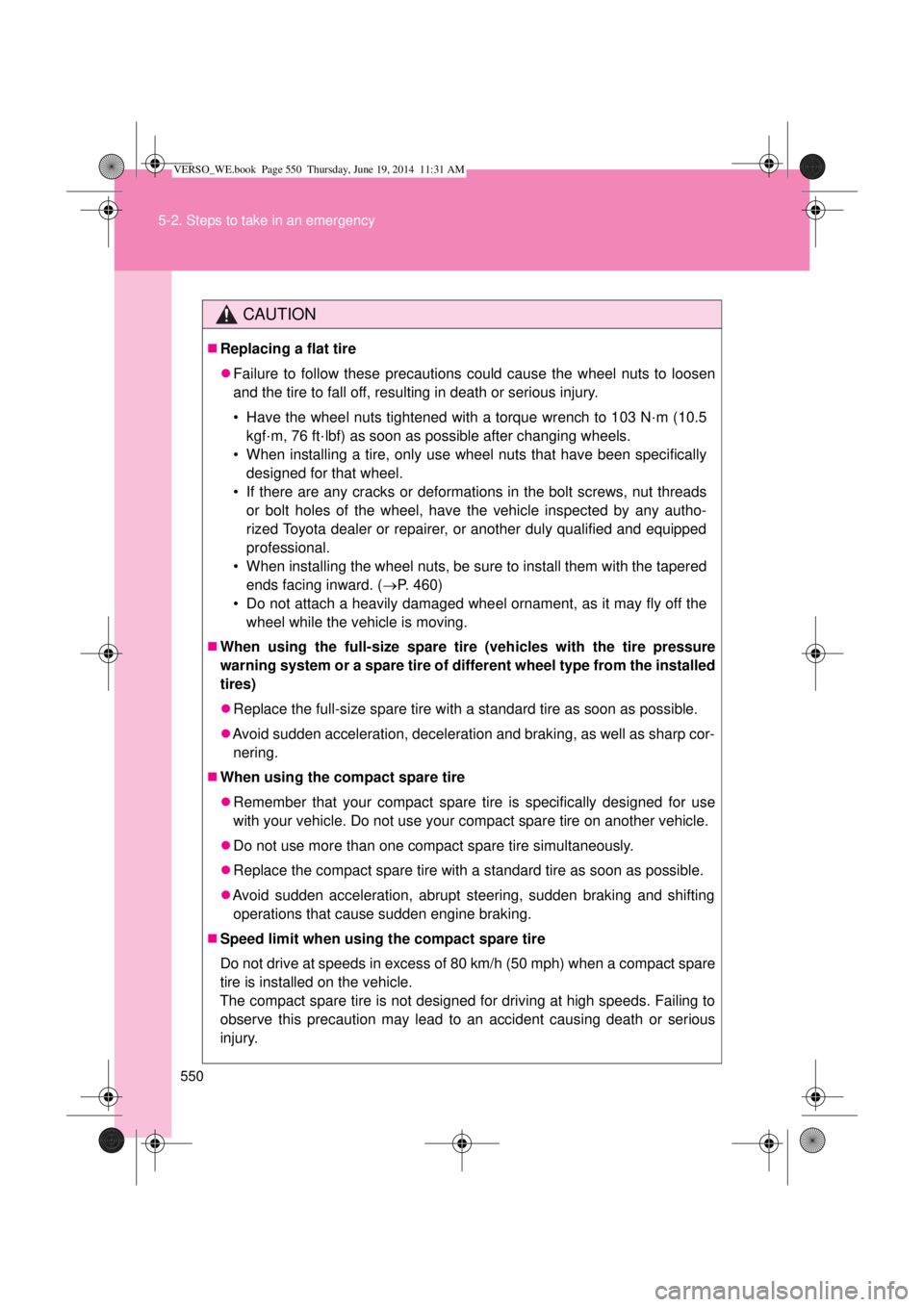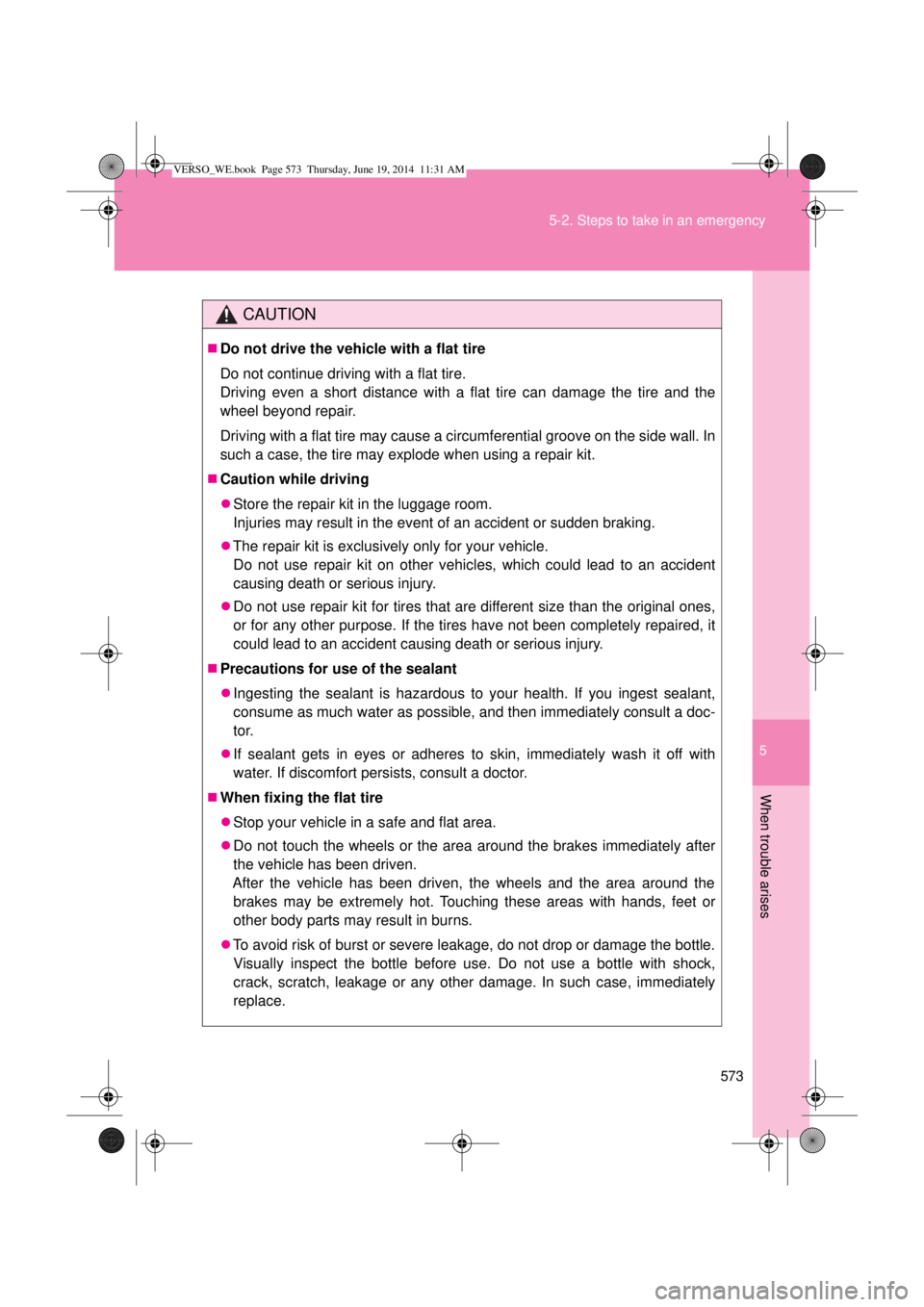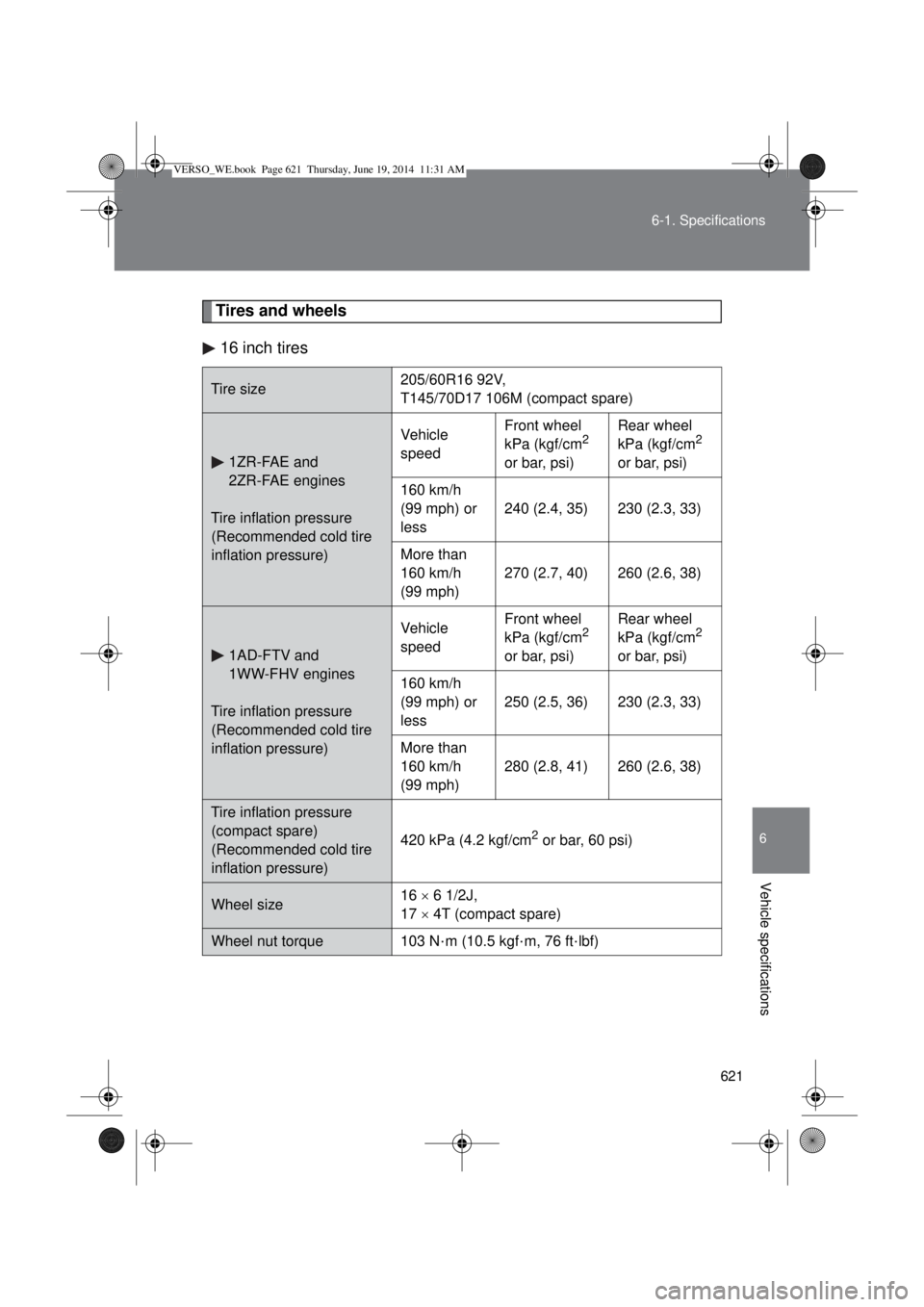Page 459 of 650

459
4-3. Do-it-yourself maintenance
4
Maintenance and care
Wheels
If a wheel is bent, cracked or heavily corroded, it should be replaced.
Otherwise, the tire may separate from the wheel or cause loss of
handling control.
Wheel selection
When replacing wheels, care should be taken to ensure that
they are equivalent to those removed in load capacity, diameter,
rim width, and inset
*.
Replacement wheels are available at any authorized Toyota
dealer or repairer, or another duly qualified and equipped profes-
sional.
*: Conventionally referred to as “offset”.
Toyota does not recommend using:
Wheels of different sizes or types
Used wheels
Bent wheels that have been straightened
Aluminum wheel precautions (if equipped)
Use only Toyota wheel nuts and wrenches designed for use
with your aluminum wheels.
When rotating, repairing or changing your tires, check that the
wheel nuts are still tight after driving 1600 km (1000 miles).
Be careful not to damage the aluminum wheels when using
tire chains.
Use only Toyota genuine balance weights or equivalent and a
plastic or rubber hammer when balancing your wheels.
VERSO_WE.book Page 459 Thursday, June 19, 2014 11:31 AM
Page 460 of 650

460 4-3. Do-it-yourself maintenance
When removing the wheel ornament (vehicles with the wheel cap clip)
When replacing wheels (vehicles with the tire pressure warning sys-
tem)
The wheels of your vehicle are equipped with tire pressure warning valves
and transmitters (except for spare tire) that allow the tire pressure warning
system to provide advance warning in the event of a loss in tire inflation
pressure. Whenever wheels are replaced, tire pressure warning valves and
transmitters must be installed.
(P. 444)
CAUTION
When replacing wheels
Observe the following precautions to reduce the risk of death or serious
injury.
Do not use wheels that are a different size from those recommended in the
Owner’s Manual, as this may result in loss of handling control.
Never use an inner tube in a leaking wheel which is designed for a tube-
less tire.
When installing the wheel nuts
Remove the wheel ornament using the
wheel cap clip.
Be sure to install the wheel nuts with
the tapered ends facing inward. Install-
ing the nuts with the tapered ends fac-
ing outward can cause the wheel to
break and eventually cause the wheel
to come off while driving, which could
lead to an accident resulting in death or
serious injury.Tapered
portion
VERSO_WE.book Page 460 Thursday, June 19, 2014 11:31 AM
Page 550 of 650

550 5-2. Steps to take in an emergency
CAUTION
Replacing a flat tire
Failure to follow these precautions could cause the wheel nuts to loosen
and the tire to fall off, resulting in death or serious injury.
• Have the wheel nuts tightened with a torque wrench to 103 N·m (10.5
kgf·m, 76 ft·lbf) as soon as possible after changing wheels.
• When installing a tire, only use wheel nuts that have been specifically
designed for that wheel.
• If there are any cracks or deformations in the bolt screws, nut threads
or bolt holes of the wheel, have the vehicle inspected by any autho-
rized Toyota dealer or repairer, or another duly qualified and equipped
professional.
• When installing the wheel nuts, be sure to install them with the tapered
ends facing inward. (P. 460)
• Do not attach a heavily damaged wheel ornament, as it may fly off the
wheel while the vehicle is moving.
When using the full-size spare tire (vehicles with the tire pressure
warning system or a spare tire of different wheel type from the installed
tires)
Replace the full-size spare tire with a standard tire as soon as possible.
Avoid sudden acceleration, deceleration and braking, as well as sharp cor-
nering.
When using the compact spare tire
Remember that your compact spare tire is specifically designed for use
with your vehicle. Do not use your compact spare tire on another vehicle.
Do not use more than one compact spare tire simultaneously.
Replace the compact spare tire with a standard tire as soon as possible.
Avoid sudden acceleration, abrupt steering, sudden braking and shifting
operations that cause sudden engine braking.
Speed limit when using the compact spare tire
Do not drive at speeds in excess of 80 km/h (50 mph) when a compact spare
tire is installed on the vehicle.
The compact spare tire is not designed for driving at high speeds. Failing to
observe this precaution may lead to an accident causing death or serious
injury.
VERSO_WE.book Page 550 Thursday, June 19, 2014 11:31 AM
Page 572 of 650

572 5-2. Steps to take in an emergency
Emergency tire puncture repair kit
The sealant stored in the emergency tire puncture repair kit can be used
only once to temporarily repair a single tire. If the sealant has been used
and needs to be replaced, purchase a new bottle at any authorized Toy-
ota dealer or repairer, or another duly qualified and equipped profes-
sional. The compressor is reusable.
The sealant can be used when the outside temperature is from -30°C
(-22°F) to 60°C (140°F).
The repair kit is exclusively designed for size and type of tires originally
installed on your vehicle. Do not use it for tires that a different size than
the original ones, or for any other purposes.
The sealant has a limited lifespan. The expiry date is marked on the bot-
tle. The bottle of sealant should be replaced with a new bottle before the
expiry date. Contact any authorized Toyota dealer or repairer, or another
duly qualified and equipped professional for replacement.
If the sealant gets on your clothes, it may stain.
If the sealant adheres to a wheel or the surface of the vehicle body, the
stain may not be removable if it is not cleaned at once. Immediately wipe
away the sealant with a wet cloth.
During operation of the repair kit, a loud operation noise is produced.
This does not indicate a malfunction.
Do not use to check or to adjust the tire pressure.
VERSO_WE.book Page 572 Thursday, June 19, 2014 11:31 AM
Page 573 of 650

5
573 5-2. Steps to take in an emergency
When trouble arises
CAUTION
Do not drive the vehicle with a flat tire
Do not continue driving with a flat tire.
Driving even a short distance with a flat tire can damage the tire and the
wheel beyond repair.
Driving with a flat tire may cause a circumferential groove on the side wall. In
such a case, the tire may explode when using a repair kit.
Caution while driving
Store the repair kit in the luggage room.
Injuries may result in the event of an accident or sudden braking.
The repair kit is exclusively only for your vehicle.
Do not use repair kit on other vehicles, which could lead to an accident
causing death or serious injury.
Do not use repair kit for tires that are different size than the original ones,
or for any other purpose. If the tires have not been completely repaired, it
could lead to an accident causing death or serious injury.
Precautions for use of the sealant
Ingesting the sealant is hazardous to your health. If you ingest sealant,
consume as much water as possible, and then immediately consult a doc-
tor.
If sealant gets in eyes or adheres to skin, immediately wash it off with
water. If discomfort persists, consult a doctor.
When fixing the flat tire
Stop your vehicle in a safe and flat area.
Do not touch the wheels or the area around the brakes immediately after
the vehicle has been driven.
After the vehicle has been driven, the wheels and the area around the
brakes may be extremely hot. Touching these areas with hands, feet or
other body parts may result in burns.
To avoid risk of burst or severe leakage, do not drop or damage the bottle.
Visually inspect the bottle before use. Do not use a bottle with shock,
crack, scratch, leakage or any other damage. In such case, immediately
replace.
VERSO_WE.book Page 573 Thursday, June 19, 2014 11:31 AM
Page 621 of 650

621 6-1. Specifications
6
Vehicle specifications
Tires and wheels
16 inch tires
Tire size205/60R16 92V,
T145/70D17 106M (compact spare)
1ZR-FAE and
2ZR-FAE engines
Tire inflation pressure
(Recommended cold tire
inflation pressure)Vehicle
speedFront wheel
kPa (kgf/cm
2
or bar, psi)Rear wheel
kPa (kgf/cm2
or bar, psi)
160 km/h
(99 mph) or
less240 (2.4, 35) 230 (2.3, 33)
More than
160 km/h
(99 mph)270 (2.7, 40) 260 (2.6, 38)
1AD-FTV and
1WW-FHV engines
Tire inflation pressure
(Recommended cold tire
inflation pressure)Vehicle
speedFront wheel
kPa (kgf/cm
2
or bar, psi)Rear wheel
kPa (kgf/cm2
or bar, psi)
160 km/h
(99 mph) or
less250 (2.5, 36) 230 (2.3, 33)
More than
160 km/h
(99 mph)280 (2.8, 41) 260 (2.6, 38)
Tire inflation pressure
(compact spare)
(Recommended cold tire
inflation pressure)420 kPa (4.2 kgf/cm
2 or bar, 60 psi)
Wheel size16 6 1/2J,
17 4T (compact spare)
Wheel nut torque 103 N·m (10.5 kgf·m, 76 ft·lbf)
VERSO_WE.book Page 621 Thursday, June 19, 2014 11:31 AM
Page 622 of 650
622 6-1. Specifications
17 inch tires
Tire size215/55R17 94W,
T145/70D17 106M (compact spare)
1ZR-FAE and
2ZR-FAE engines
Tire inflation pressure
(Recommended cold tire
inflation pressure)Vehicle
speedFront wheel
kPa (kgf/cm
2
or bar, psi)Rear wheel
kPa (kgf/cm2
or bar, psi)
190 km/h
(118 mph)
or less240 (2.4, 35) 230 (2.3, 33)
More than
190 km/h
(118 mph)270 (2.7, 40) 260 (2.6, 38)
1AD-FTV, 2AD-FHV and
1WW-FHV engines
Tire inflation pressure
(Recommended cold tire
inflation pressure)Vehicle
speedFront wheel
kPa (kgf/cm
2
or bar, psi)Rear wheel
kPa (kgf/cm2
or bar, psi)
190 km/h
(118 mph)
or less250 (2.5, 36) 230 (2.3, 33)
More than
190 km/h
(118 mph)280 (2.8, 41) 260 (2.6, 38)
Tire inflation pressure
(compact spare)
(Recommended cold tire
inflation pressure)420 kPa (4.2 kgf/cm
2 or bar, 60 psi)
Wheel size17 7J,
17 4T (compact spare)
Wheel nut torque 103 N·m (10.5 kgf·m, 76 ft·lbf)
VERSO_WE.book Page 622 Thursday, June 19, 2014 11:31 AM
Page 633 of 650
633
6
Vehicle specifications
6-3. Initialization
Items to initialize
*: Diesel engine only
ItemWhen to initializeReference
Engine oil mainte-
nance data
*After changing engine oil P. 428
Tire pressure
warning system
(if equipped)• When rotating the tires on
vehicles with differing front
and rear tire inflation pres-
sures
• When changing tire pressure
(such as when changing trav-
eling speed)
• When changing the tire sizeP. 445
The following item must be initialized for normal system operation in
cases such as after the battery is reconnected, or maintenance is
performed on the vehicle.
VERSO_WE.book Page 633 Thursday, June 19, 2014 11:31 AM